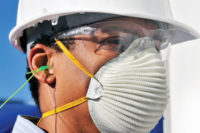Even if you are already familiar with the need for and use of respirators in your workplace, it’s important to periodically review your current program against standard operating procedures governing the selection and use of respirators.
Key elements
According to program details in OSHA’s Respiratory Protection Standard (29 CFR 1910.134), the seven key elements that every respiratory protection program must contain are:1) A written plan detailing how the program will be administered.
2) A complete assessment and knowledge of respiratory hazards that will be encountered in the workplace.
3) Procedures and equipment to control respiratory hazards, including the use of engineering controls and work practices designed to limit or reduce employee exposures to such hazards.
4) Guidelines for the proper selection of appropriate respiratory protective equipment.
5) An employee training program covering hazard recognition, the dangers associated with respiratory hazards, and proper care and use of respiratory protective equipment.
6) Inspection, maintenance, and repair of respiratory protective equipment.
7) Medical surveillance of employees.
Let’s briefly review a few of these key elements.
Hazard assessment
Some respirator manufacturers make it easy for safety managers and individuals to select appropriate respiratory protection by offering an interactive respirator selector guide. Encompassing the broadest range of available respirators, a guide can give you choices that you didn’t know you had. A respirator selector guide also helps you choose the correct filtering element if your exposure situation allows the use of an air-purifying respirator.Hazard assessment is the first step in using the respirator selector guide. Determine what the environmental conditions are so you know what you are up against.
Conduct proper air sampling to determine an atmosphere’s oxygen content and/or concentration level of gaseous contaminants. The results of this sampling will be the basis for how you address the need for respirators and, if needed, what level of protection is required. Generally, respirator (and cartridge) selection is based on three factors:
Also key to hazard assessment is whether the contaminant has adequate warning properties. This affects respirator selection, in that chemical cartridge respirators and gas masks should be worn for routine use against only those gases and vapors with adequate warning properties, unless the cartridge is equipped with an end-of-service-life indicator. After finding out what hazards exist, compare the chemical concentration at your facility (determined by air sampling) with the chemical’s exposure limits.
Respirator selection
One of the most important attributes of a respirator is its dependability. Someone’s life may depend on it. Choose the sturdiest, most cleanable respirator you can afford, with respirator filter media that specifically protect from the expected contaminant or hazard in your workplace. Work with your respirator manufacturer to determine your best choice.Your respirator should be NIOSH-certified for your specific hazard and otherwise in compliance with NIOSH 42 CFR Part 84. Selecting respirators entails knowing what level of respiratory protection employees need, as well as which size respirator is right for any face and facial contours.
Respiratory protective devices vary in design, application and protective capability. Thus, the user must assess the inhalation hazard and understand the specific use limitations of available equipment to assure proper selection.
If your calculation shows that exposure concentrations exceed recommended limits, and engineering/administrative controls do not reduce exposure below the permissible limit, tailor your respiratory protection program to your specific conditions based on:
- toxicity (TLV or TWA);
- maximum expected concentration;
- oxygen level;
- IDLH concentration;
- warning properties (adequate or not);
- sorbent limitations;
- facepiece fit;
- mobility requirements;
- type of use (routine, escape or emergency entry).
Maintenance issues
One of the most important things in respirator maintenance is to use only replacement parts authorized by the original respirator manufacturer to maintain the government (NIOSH) certification assigned to the respirator when it was new.Clean and disinfect the equipment before and after each use and before storing, so the respirator will be ready to use when needed. Follow the user’s instruction manual. Never use extremely hot water, abrasive cleaners, or high-pressure air or water to blow or flush away dirt.
After the respirator is clean and dry, reassemble and inspect it. Look for non-conforming, missing or damaged parts. Because air follows the path of least resistance, cracks or holes might allow unfiltered air into your breathing zone. Check for distortion, cracks, tears and folds that might affect the sealing surface and the essential face-to-facepiece seal. All cartridges and filters must be intact, with mounting surfaces in good condition. Workers with full-facepiece respirators should check the viewing lens for scratches or anything that impedes visibility.
Many online, on-demand training programs feature step-by-step inspection procedures.
So remember, even though your facility may be streamlining its operations, one area you cannot afford to skimp on is respiratory protection for your workers. Following the guidelines presented herein will help you not only make the right equipment choices but also get maximum production out of that equipment.
